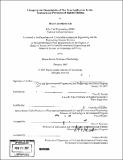Changes in the characteristics of new drug applications for the treatment and prevention of diabetes mellitus
Author(s)
Lin, Hsiao-Lan Sharon
DownloadFull printable version (19.55Mb)
Other Contributors
Massachusetts Institute of Technology. Technology and Policy Program.
Advisor
Ernst R. Berndt and Fred Moavenzadeh.
Terms of use
Metadata
Show full item recordAbstract
Efforts in managing diabetes, including the medical advances in novel therapies and public health policies of disease control and prevention, have not reduced the disease prevalence since 1990s. I analyze this phenomenon from the technology and policy viewpoints underlying diabetes treatment and prevention, in order to control and manage the disease in a cost-benefit balanced manner. The innovative performance of the antidiabetic drug therapy is investigated by analyzing the fifteen New Drug Applications (NDAs) of the antidiabetics approved by the US Food and Drug Administration since the early 1990s. I examine the characteristics of the clinical trials supporting NDAs and observe how the complexity of clinical trials has changed over time. Nine out of the twenty-five selected indicators are found to exhibit an increasing trend of complexity. The trend is more pronounced in the oral antiglycemics group (seven indicators) than the subcutaneous group (two indicators). Interestingly, this trend in increasing complexity in clinical trials is generally consistent with that of the increasing R&D costs in the pharmaceutical industry, possibly account for the declining innovative performance of the industry over the time period under investigation. A system dynamics approach is applied to assess current public health policies in diabetes control and prevention. (cont.) The benefit of system thinking is to avoid potential policy resistance by identifying the problematic characteristics of the system, such as time-delays, feedback, and structure of stocks and flows. For diabetes management, the public health system can be considered a "dynamic-complex" system in terms of current policy made by the National Diabetes Control and Prevention Program. Despite providing earlier and expanded screening as well as improved availability and accessibility of treatment for diabetes, the policy results in the increase of prevalence. More undiagnosed people are diagnosed, thus increasing the incidence, whereas people already diagnosed prolong their lifespan due to the better and more accessible medical care. A future successful chronic disease management program should systematically integrate the efforts from both the treatment and prevention perspectives.
Description
Thesis (S.M.)--Massachusetts Institute of Technology, Dept. of Civil and Environmental Engineering; and, (S.M.)--Massachusetts Institute of Technology, Engineering Systems Division, Technology and Policy Program, 2007. Includes bibliographical references (p. 99-102).
Date issued
2007Department
Massachusetts Institute of Technology. Department of Civil and Environmental Engineering; Massachusetts Institute of Technology. Engineering Systems Division; Technology and Policy ProgramPublisher
Massachusetts Institute of Technology
Keywords
Civil and Environmental Engineering., Technology and Policy Program.